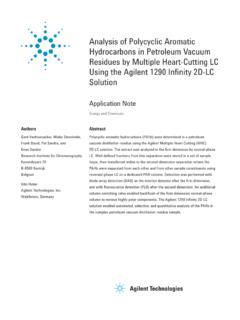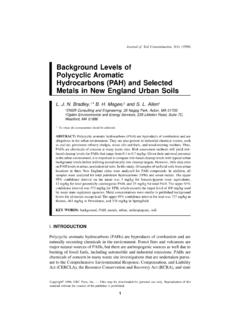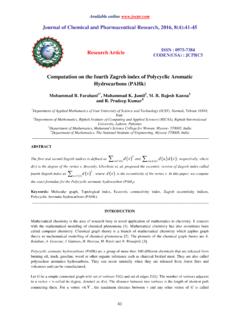Transcription of FEICA guidance on evaluating the food contact …
1 FEICA guidance Brussels, 05/05/2017 FEICA guidance on evaluating the food contact status for adhesives containing mineral oil hydrocarbons Content Executive Summary .. 2 Types of mineral oil hydrocarbons .. 2 Sources of mineral oil hydrocarbons in food .. 3 Food contact materials .. 3 Contaminants .. 3 Food additives, processing aids and other uses .. 3 Potential health issues .. 3 Testing for mineral oil hydrocarbons .. 5 Risk assessment of non-listed raw materials, including mineral oils .. 6 Conclusions from the EFSA Opinion .. 6 FEICA s recommendations for the adhesive industry .. 6 Water-based adhesives with expected food contact .. 7 Hotmelts with expected food contact .. 7 Pressure-sensitive adhesives (hotmelt) with expected food contact .. 8 Pressure-sensitive adhesives (water-based) with expected food contact .. 8 Conclusion.
2 9 Technical Appendix .. 10 mineral oil hydrocarbon compounds evaluated by EFSA .. 10 mineral Oil in Adhesives .. 12 Decision Tree for Downstream User Evaluation of Adhesives .. 13 contact for more information .. 14 FEICA | GUP-EX-G05-019 Page 2 of 14 Executive Summary In 2011, health concerns were raised after studies were published indicating that consumers could be exposed to mineral oil hydrocarbons (MOH) in foodstuffs, with the likely major sources being food packaging and additives, processing aids, and lubricants. The EFSA opinion1 put the main focus on mineral oil migration from recycled paper, where the mineral oil from the printing inks was a major contributor to the contamination of the packed food. The supporting studies were published by the Official Food Control Authority of the Canton of Zurich, Switzerland. Despite the fact that several new studies have been published since the EFSA opinion, the situation remains complex and challenging for the whole supply chain.
3 For adhesives, the lack of official analytical methods especially for simulating migration means that the test results may not reflect reality. In addition, adhesives raw materials multi-constituent substances such as mineral oils, waxes, resins and oligomers are difficult to analyse, especially in complex matrices. In this guidance document, FEICA aims to provide some clarification on how to risk assess mineral oil hydrocarbons in adhesives and, in case testing is needed, how to perform the test and evaluate the results. A decision tree is also included to allow customers to evaluate an adhesive for its intended application. This guidance aims to support adhesives producers and their downstream users in making sure that the adhesive in its intended application complies with article 3 of the Framework Regulation 1935/2004.
4 Types of mineral oil hydrocarbons The term mineral oil is imprecise and encompasses a wide range of mixtures of hydrocarbons. The EFSA opinion defines mineral oil hydrocarbons (MOH) or mineral oil products as: hydrocarbons containing 10 to about 50 carbon atoms, where the crude mineral oils remain by far the predominant source of the MOH considered, but equivalent products can be synthesised from coal, natural gas or biomass. This definition includes all the various refinery grades and also substances which are evaluated as non-hazardous or not harmful to humans or the environment. Highly purified mineral oils and paraffins have been used in cosmetic or medical applications for decades and for food and food contact applications as well. They are approved and supported by adequate toxicological data. Thus, mineral oils are part of our daily life and an accurate differentiation in their toxicological evaluation should be the key in every discussion.
5 The EFSA opinion divides MOH into two main types: mineral oil saturated hydrocarbons (MOSH), which comprise linear and branched alkanes, and alkyl-substituted cyclo-alkanes. mineral oil aromatic hydrocarbons (MOAH), which comprise mainly alkyl-substituted polyaromatic hydrocarbons. However, even this categorisation is imprecise due to a lack of a precise definition of MOSH and MOAH. The MOSH and MOAH fractions are mainly determined by the results derived through the commonly used analytical Because of their complexity, it is not possible to resolve MOH mixtures into individual components for 1 2 The most frequently used testing method is based on on-line coupled HPLC-GC-FID (high performance liquid chromatography gas chromatography flame ionisation detector), published by the Zurich Cantonal Laboratory (KLZH) and Germany s Federal Institute for Risk Assessment (BfR).
6 3 FEICA | GUP-EX-G05-019 Page 3 of 14 Sources of mineral oil hydrocarbons in food The European Food Safety Authority Panel on Contaminants in the Food Chain (CONTAM Panel) identified the following potential sources of mineral oil hydrocarbons in food (EFSA 2012 Scientific Opinion on mineral Hydrocarbons in Food , The EFSA Journal 10(6):2704, pp 140 - 141).: Food contact materials Food packaging materials made from recycled paper and board. Off-set printing inks applied to paper and board for food packaging. mineral oils used as additives in the manufacture of plastics for food contact ( internal lubricants in polystyrene, polyolefins). Wax paper and board. Jute or sisal bags with mineral batching oil. Lubricants for can manufacture. Wax coating directly applied to food. In addition, some types of adhesives may contain mineral oil hydrocarbon components.
7 Contaminants Environmental contaminants: lubricating oil from engines without catalyst (mainly diesel), unburned fuel oil, debris from tyres and road bitumen. Harvesting machinery: diesel oil, lubricating oil. Lubricating oils in pumps, syringe type dosing machinery and other industrial installations used in food processing. Cleaning agents, solvents consisting of pure MOH or C10-C14 mixtures. Food additives, processing aids and other uses Release agents for bakery ware and sugar products. Oils for surface treatment of foods, such as rice, confectionery. mineral oils in feeds, binders for minor additives added as powder. Defoamers. Authorised paraffinic waxes ( for chewing gum or coating of certain fruits). Pesticide formulations. Anti-dusting agents for cereals. Potential health issues The MOSH and MOAH paradigm is a generic terminology that is used to describe an analytical fraction and is an overall descriptor of hydrocarbons from variable petroleum, synthetic and in some cases even natural sources.
8 Because of the diverse nature of MOH, there is a lack of reference standards for human exposure and information relating to actual health effects. Although the European Food Safety Authority identified potential concerns about MOH in food, it acknowledged considerable uncertainties in assessing any potential risks and concluded that further studies were needed (see Technical Appendix). FEICA | GUP-EX-G05-019 Page 4 of 14 According to EFSA 2012 (last update)4, MOSH and MOAH exhibit the following properties: MOSH, mainly the fraction comprising carbon chains of 16 - 35 atoms (C16 - C35), may accumulate in the human body, especially in lymph nodes, spleen and liver. However, EFSA has also stated that this has not been associated with adverse health consequences. (Note that this has been explained further by pathologist K.)
9 Fleming at MOCRINIS 20135.) MOAH with three or more, non- or simple-alkylated, aromatic rings may be mutagenic and carcinogenic, and is therefore considered by the European Food Safety Authority Panel of higher concern than the MOSH fraction. In general, toxicologists focus on polycyclic aromatic hydrocarbons (PAH) and especially 3-7 ring PAH. Unlike these 3-7 ring polycyclic aromatic compounds, of which some are known to be carcinogenic, highly alkylated 1-2 ring systems are not genotoxic and many are not considered to be a concern for carcinogenicity6,7,8, 9. Hence, although these species are likely to contribute to the MOAH identified in MOH products, they, in and of themselves, do not pose a carcinogenic risk in the MOH products. To conclude, the presence of MOAH in itself is not indicative of a carcinogenic potential.
10 This must be taken into consideration when performing a risk assessment on MOH in adhesives intended for food EFSA have assessed a few MOH that are listed and specified on the positive list of the Plastics Regulation EU/10/2011. As they are included among chemicals that could be safely used in plastics production intended for food contact , these MOH are also assumed to be safe in use for the production of adhesives intended for food packaging. See Technical Appendix for the full list of EFSA assessed MOH including their descriptions and specifications. 4 5 6 Florin I, Rutberg L, Curvall M, Enzell CR (1980) Screening of tobacco smoke constituents for mutagenicity using the Ames' test. Toxicology 15: 219-232 7 H ke H, Zellerhoff R (1998) Metabolism and toxicity of diisopropylnaphthalene as compared to naphthalene and monoalkyl naphthalenes: a minireview.





